Reverse osmosis systems are among the most effective filtration systems to remove contaminants from drinking water. However, some minerals, such as iron, can not only be harmful to human health but also to water filters.
Reverse osmosis systems can remove iron from water. The semi-permeable membrane can effectively remove 98-99% of all iron in water, including ferrous (soluble), ferric (insoluble) and organic. Semi-permeable membranes made of thin composite film are particularly effective.
This article will take you through what iron is, how it enters out water supply and why we should remove it, especially from our drinking water. We’ll explain in detail how a reverse osmosis system removes iron from water and recommend the 4 best reverse osmosis systems that can remove iron from water.
What is iron?
Iron is a versatile element that is found almost everywhere, from the inner core of the Earth to the blood in our veins, and is an essential mineral.
While iron is found in our water, it’s naturally present in many foods, and is often used as a dietary supplement and to fortify some foods.
In fact, iron is so important that a deficiency of iron can lead to anaemia, most especially in children, and can impact the ability of our blood to transport oxygen throughout the body.
Many people are familiar with the way iron in food is described. Those types of iron include:
- Heme iron – iron that comes from animal-based products, i.e., meat.
- Non-heme iron – iron that predominantly comes from plant-based foods, but can be in animal-based products.
However, the main forms of iron in water are:
- Ferrous iron – a soluble (dissolves in water) iron where your water is completely clear and colorless.
- Ferric iron – insoluble (won’t dissolve in water) iron that can result in brown, red, orange or yellow colored water.
There are two additional forms of iron that are typically less problematic, which are organic iron or tannins (from vegetation) and iron oxidizing bacteria.
Our bodies need iron for growth and development. However, like everything else, consuming too much iron can cause health issues in people.
According to research, your daily requirement for iron is influenced by your age, sex, and whether or not you eat a predominantly plant-based diet. The milligrams of the average daily recommended levels are provided below for reference.
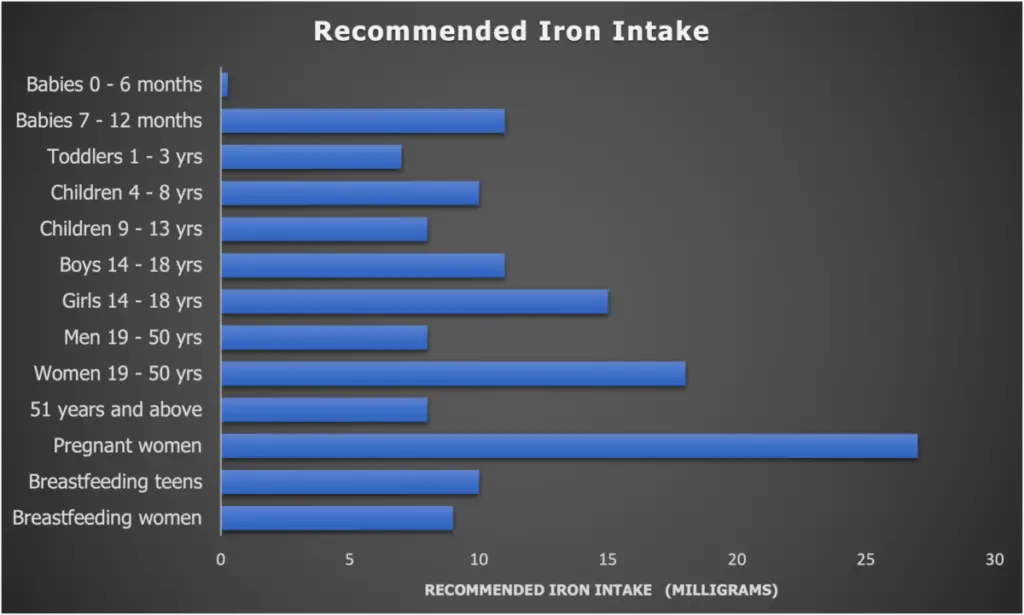
However, it is also possible to consume or bioaccumulate excessive amounts of iron, which can negatively impact your health.
Negative effects of iron
Iron is not usually detrimental to human health, as the body requires it for several body functions, such as maintaining oxygen supplies in our blood. However, too much of it can be harmful.
Human blood naturally contains high levels of iron. As a result, people who frequently receive blood transfusions, such as those undergoing cancer treatment, can be in danger of consuming too much iron.
This disorder is called ‘Iron overload‘ and it occurs because your body is unable to eliminate the excess iron.
Studies have shown too much iron can lead to:
- Liver damage, including cirrhosis
- Pancreatic islet cell damage
- Diabetes
- Hypothyroidism
- Hypogonadism.
Ultimately, the excess iron affects the organs, including the liver, pancreas, heart, thyroid, gonads, and pituitary as well as our joints and skin.
Hemochromatosis, which is a predominantly hereditary disease, can also result in iron overload. Its early indications include fatigue, weight loss, and joint discomfort. Although, the excess iron can also cause nausea, vomiting, and digestive issues.
Unfortunately, the body has no way of removing excess iron and it continues to build up and damage our cells over time.
Some studies even suggest that too much iron can lead to cancer.
Excessive amounts of iron can affect almost every part of our body, even our skin – causing wrinkles, discoloration (bronze or gray), and eczema or acne.
In fact, the CDC recommends anyone that suffers from iron overload or hemochromatosis should drink bottled water to reduce their iron intake.
Apart from the negative health effects, high concentrations of iron in our water has some negative impacts on things around the home, including our laundry, food, and other devices/appliances. Iron is able to:
- Give a metallic flavor to our drinking water and change the flavor of our food.
- Stain laundry, plumbing, and dishes (stains are usually yellow, red, or brown).
- Can turn coffee, tea, and potatoes black.
- Clog or block wells, pumps, sprinklers, dishwashers, and other water using equipment around the home.
How iron enters the water supply
Iron is found in almost all types of rocks and soils. Rainwater naturally seeps into the ground and comes into contact with these underlying rock formations. Over time the water dissolves or breaks down the rock and releases its minerals, including iron (and also calcium, magnesium etc) into our groundwater.
A large proportion of the water used by community and public water systems is sourced from groundwater, not to mention the nearly 50 million residents that use domestic wells for their drinking water. This inherently puts us at risk of drinking water with high iron concentrations.
The corrosion of old galvanised iron pipes also releases iron directly into a home’s water supply.
Iron in drinking water is usually below 10 parts per million (ppm) or 10 mg/L. However, the recommended limit for the odor and taste of iron is just 0.3 mg/L.
You can determine the type of iron that is in your drinking water and how best to remove it from the table below:
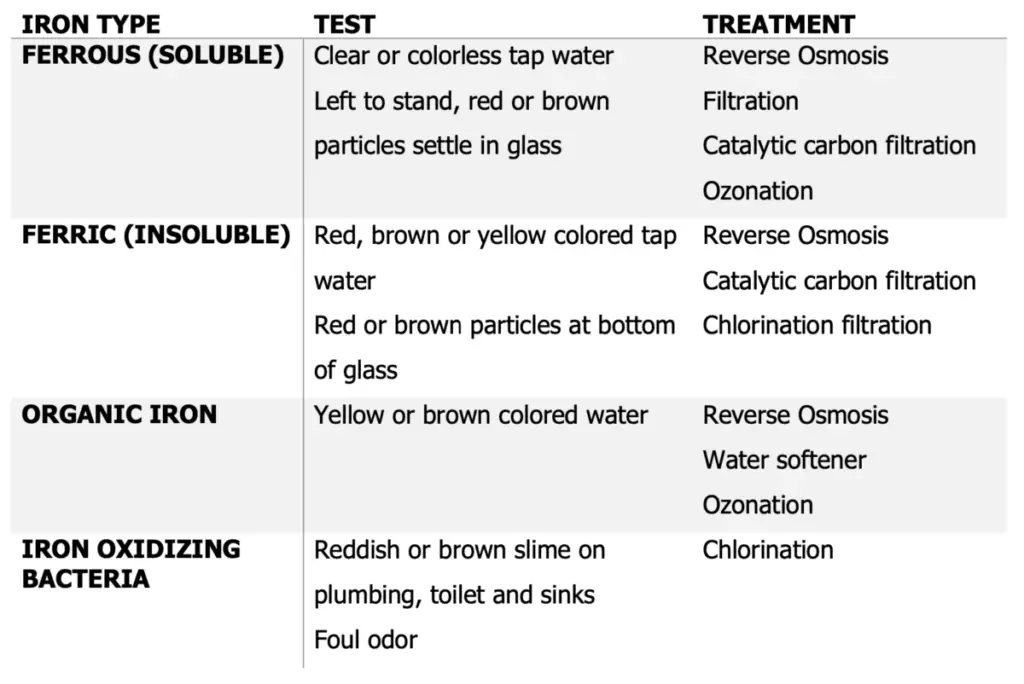
How reverse osmosis systems remove iron
Reverse osmosis is a simple and affordable method for purifying the drinking water in your home by removing chemical and metal pollutants, including iron.
Reverse osmosis uses pressure to push contaminated water through a semi-permeable membrane, which is similar to a filter, but with even smaller pores. Total dissolved particles, pollutants, metal ions, and mineral ions, including all forms of iron, are eliminated from the water, leaving only clean water behind.
The majority of the iron becomes attached to the semi-permeable membrane media as the water travels to the next filtration stage.
Reverse osmosis systems have several filtration stages, including a sediment pre-filter stage, carbon pre-filter stage, membrane, and sometimes a post-filter:
Sediment prefilter
This is the very first stage of the reverse osmosis filtration system, where larger contaminants such as dust, sediment, debris, and dirt are removed from the water by being trapped before the water moves to the next stage.
Large particles of ferric (insoluble) iron, such as rust, are removed by the sediment prefilter.
Carbon filter
The second filtration stage, the carbon filter, removes pollutants including chlorine, volatile organic compounds (VOCs), bad odors, and PFAS while enhancing the water’s flavor.
Ferric (insoluble) iron is removed by activated carbon filters. Granular activated carbon (GAC) filters are particularly effective.
Semi-permeable membrane
This is the most important filtration stage in a reverse osmosis system, it is where the majority of contaminants, including any remaining iron (and other contaminants) is removed.
The semi-permeable membrane, such as a thin film composite membrane, can remove 98-99% of all iron (ferric, ferrous and organic) in water.
Post filter
The reverse osmosis filtration process ends often ends with a post filter (excluding tankless systems). This filter is used to remove any contaminants that have been introduced to the water while it was in the storage tank/reservoir.
This step ensures that the RO delivers the highest-quality, contaminant-free drinking water to your faucet. The post filter does not typically remove iron.
note: One key thing to remember is that high iron concentrations in water will also clog and block the filters and membrane quickly. If you are using a reverse osmosis system to remove iron you may need to replace the filters more regularly than recommended by the manufacturer.
Reverse Osmosis Systems that Remove Iron
Here are the top reverse osmosis systems for purifying tap and well water of iron (and other contaminants of concern).
1. Waterdrop 800 GPD
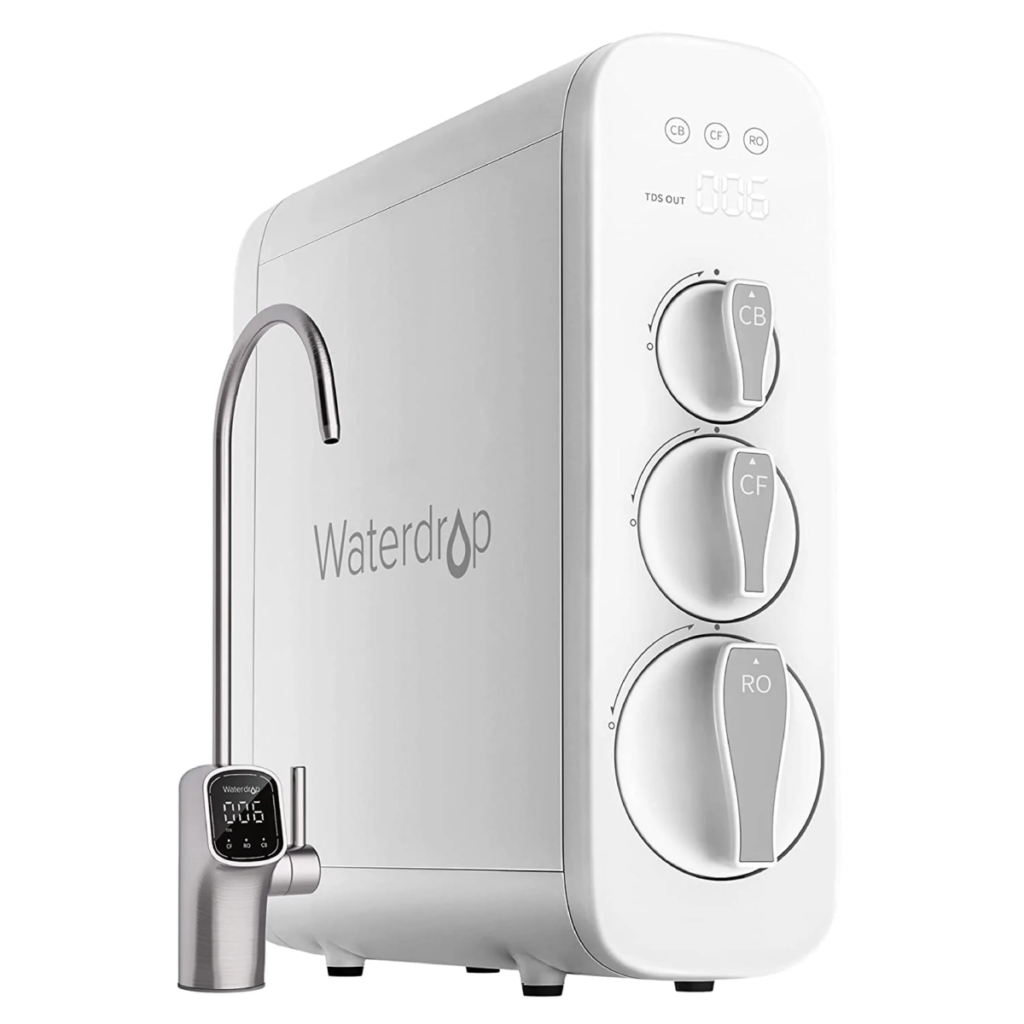
The Waterdrop 800 GPD Tankless Reverse Osmosis System is a 3-stage filtration system with 7 layers of membrane that can effectively remove iron. This system also removes PFAS, fluoride, heavy metals like chromium, and arsenic, and salts like nitrate and chloride.
In fact, it removes 1000+ harmful substances.
It has a smart faucet that allows you to quickly see the TDS level and water quality. Its tankless design helps to prevent secondary contamination and saves 70% of space under the sink.
This incredible reverse osmosis system has many intelligent features, including a malfunction alarm, TDS monitor, and filter life indicator. It is BPA-free and Lead-free.
Unlike many other systems it has a fast flow rate so you are never waiting for clean water to drink.
2. Frizzlife 600 GPD
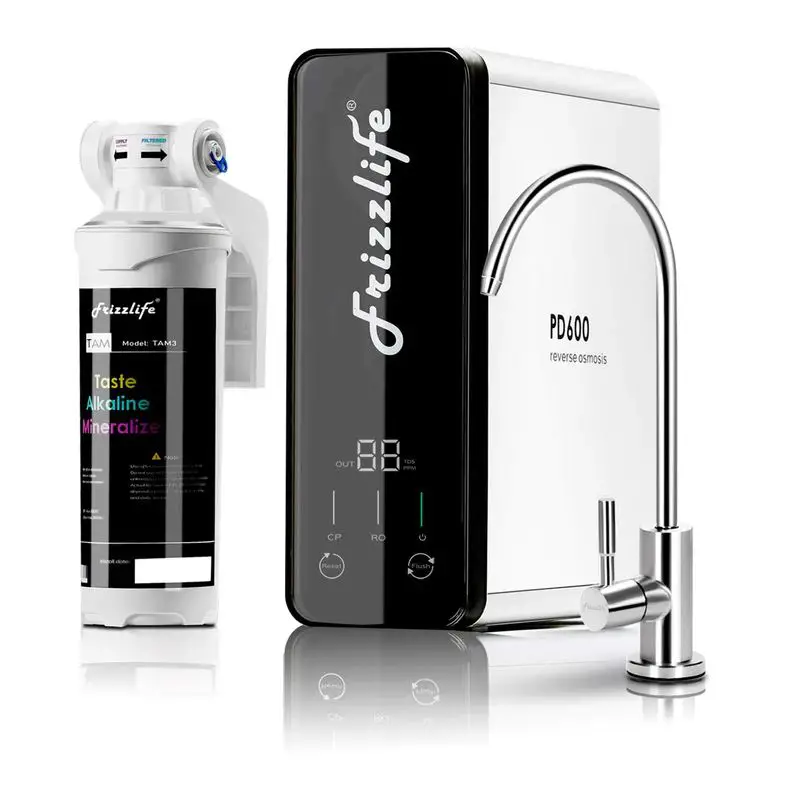
The Frizzlife 600 GPD RO is a compact and sleek tankless design reverse osmosis system that can remove up to 99.99% of contaminants, including iron, chlorine, lead, heavy metals, fluoride, mercury, VOCs, chloramine, arsenic, and much more.
The Alkaline Remineralization Filter (TAM3) restores natural minerals, balances the alkalinity of RO water, and adjusts the pH to improve the taste and smell of the decontaminated water.
It also has a smart display panel that clearly displays the TDS and remaining life of each filter in real-time. This integrated system continuously assesses your drinking water’s purity around the clock. The color-coded indicators serve as an intelligent reminder that prompts you to switch filters ahead of time as needed.
3. Crystal Quest 3000c under sink system
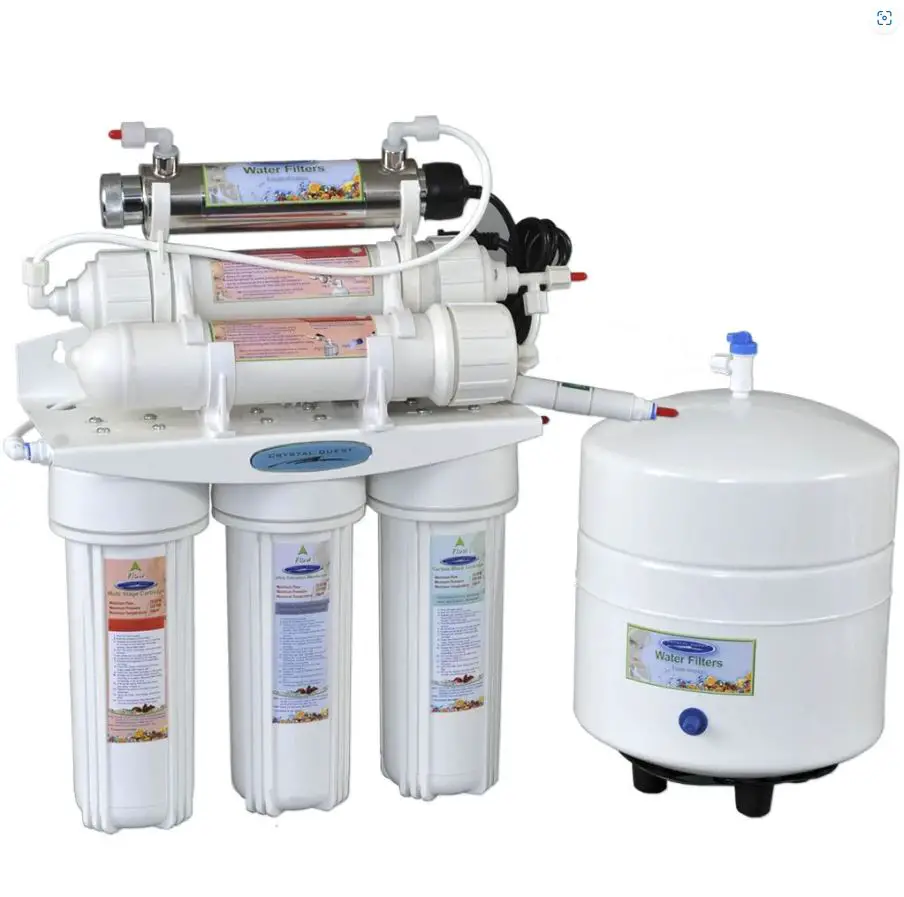
Granulated Activated Coconut Shell Carbon (GAC) Filter Cartridges and post-membrane cartridges are used in the 13-stage reverse osmosis system Crystal Quest to remove 99.9% of contaminants, including iron, volatile organic carbon compounds (VOCs), insecticides, pesticides, bacteria, viruses, parasites, protozoa, pyrogens, and industrial solvents.
Heavy metals including lead, mercury, copper, nickel, chromium, cadmium, aluminum, and other dissolved metals are naturally eliminated from the water via the process of electrochemistry, whereas iron and hydrogen sulfide must be converted into insoluble materials and attach to the surface of the membrane.
Similar to a magnet, they are drawn to the media’s (membrane) surface. This media prevents the growth of bacteria throughout the entire system to avoid more contamination.
4. Ispring reverse osmosis system
iSpring’s reverse osmosis system is specifically designed to remove iron and manganese. Its third stage filter, substantially lowers the concentration of iron in water, making it clean and safe to drink.
Due to the catalytic medium not being consumed during the process, the filter can last up to three times longer than other leading types of filters. Along with these iron and manganese, the iSpring system also gets rid of sediment, chlorine, rust, pesticides, industrial solvents, and other things.
Related Questions
Does a Brita filter out iron?
In general, Brita filters cannot remove iron from water. However, Brita’s whole home water purification system “Brita Pro” can effectively remove iron.
Does Zero water filter out iron?
Zero water can effectively remove 99% of iron from drinking water. The 5-stage filtration system is more effective than the 2-stage, however both remove iron from water.
What is the best iron removal media?
Manganese greensand filters and catalytic filters are the most effective removal media for iron. Other effective methods include reverse osmosis systems and ozonation.
Does hard water cause high iron?
Hard water usually contains high concentrations of absorbed minerals, such as iron. Therefore, areas with hard to very hard water are often contain high iron content.
Is it ok to drink well water with high iron?
It is not safe to drink well water with excessively high iron content, in particular if the iron is from organic or iron oxidizing bacteria sources. Testing the well to determine the iron concentration (and other contaminants) is advizable before drinking.

